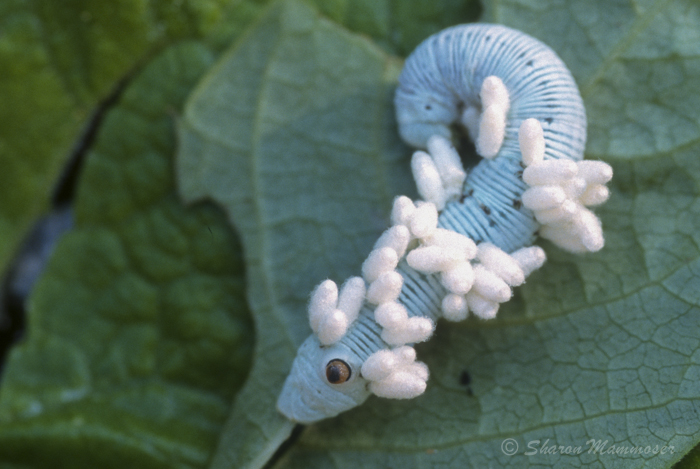 It would be tough to be a caterpillar! They have many challenges to overcome before they can transform into beautiful winged adults. Did you have any guesses for last week’s puzzler?
It would be tough to be a caterpillar! They have many challenges to overcome before they can transform into beautiful winged adults. Did you have any guesses for last week’s puzzler?
This photo is of a spinx moth caterpillar–notice the fake eye spot on the one end of its body. Potential predators like birds might be scared away by this. But what about all of those white things that look like rice grains on the caterpillar’s body? In nature, there are many animals that are parasites, meaning they live in or on another organism (its host) and benefit by getting nutrients at the host’s expense. Mosquitoes and ticks are two parasites that most people would be familiar with. How about an ichneumon or a braconid wasp? Have you heard of these? Both are parasitic insects whose life cycle depends on a host organism–another insect.
In this picture, the white things on the caterpillar’s body are the cocoons of Braconid wasp pupae. The female wasp lays her eggs directly into the skin of the caterpillar. When the eggs hatch, they live inside the caterpillar, feeding on it as they grow–basically eating the unlucky caterpillar alive. Then they chew through the outer skin of the caterpillar and spin a silken cocoon on the caterpillar’s body. When they emerge as adults, the caterpillar will die. Wow, talk about gruesome, right?
In North America, there are more than 15,000 members of the Braconidae family so identification is difficult. Many are specialized to a particular host, like aphids or a family of caterpillars such as the tomato hornworm caterpillars. Farmers will be glad to know these wasps are actually their friends, killing many of the crop-damaging caterpillars before they can do their damage. Have you ever seen a caterpillar with these cocoons on it?


1 thought on “Weekly Puzzler Answer # 11”
Comments are closed.